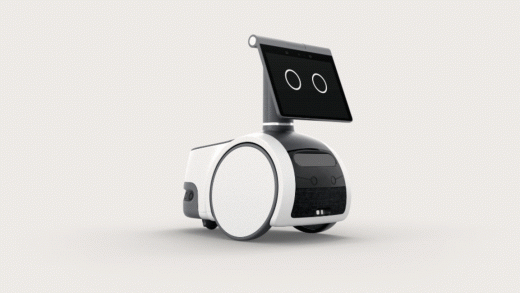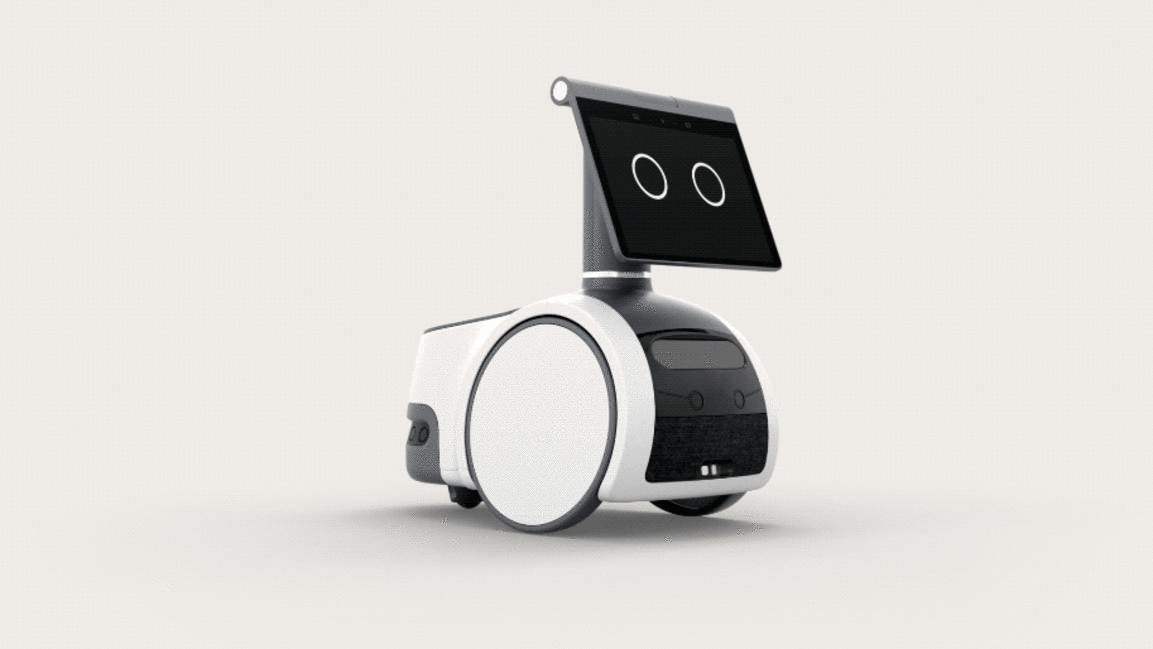Amazon’s Astro home robot is ‘Alexa on wheels’—and much more
“Alexa, ask Astro to come in here.”
I’m sitting on a couch in a simulated living room at Amazon’s Lab126 product R&D lab in Sunnyvale, California. Amazon VP of products Charlie Tritschler, who has been describing the company’s new home robot to me, is summoning the bot from another room, where it’s been biding its time before making an appearance.
The squat, gleaming white bot rolls through the door and into the area where Tritschler, principal product manager Anthony Robson, and I have been discussing it. After negotiating a carpet, it whirs in my direction. But it eventually uses facial recognition to spot Tritschler, who’s in a nearby armchair, and wheels up to him.
Code-named “Vesta,” Astro has been in the works for four years—and has been the subject of rumor and speculation for almost as long. The robot has been described as “Alexa on wheels,” which is accurate as far as it goes: It uses Amazon’s voice assistant for control and packs features—from video calls to music playback—available on other Alexa-powered devices. With its ability to monitor homes for intruders and other risks to safety, Astro is also an extension of Amazon’s security ecosystem, most of which otherwise involves products sold under its Ring brand.
But this product’s implications go far beyond those of a new Echo Show smart screen or Ring video doorbell. Rosie, the Jetsons’s robotic maid, has been a symbol of life in the future for almost 60 years; attempts to market household robots go back at least to the 1980s. Yet aside from iRobot’s Roomba and other floor-cleaning bots, useful home robots feel no closer to reality than flying cars and personal jetpacks. With Astro, Amazon aims to change that.
However, the company isn’t claiming that its robot is ready for the masses just yet. Astro will debut as a Day 1 Edition, part of an invitation-only program that will allow a select group of people to buy it for $1,000, marked down from the official price of $1,500. You can request an invite starting today, and Amazon plans to begin accepting participants and shipping Astros later this year. Early adopters will help shape the product’s future: “Our goal is to get feedback from people,” says Tritschler.
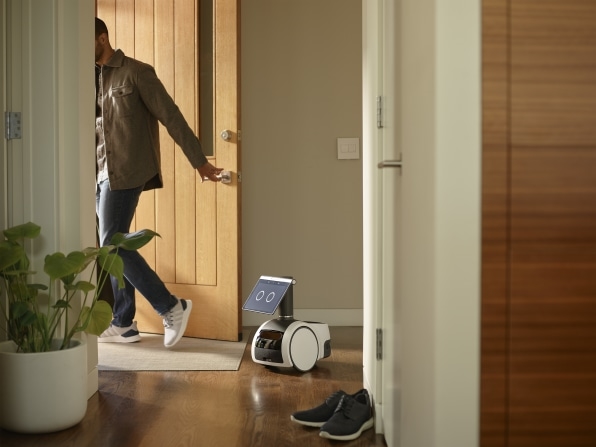
Birth of a bot
According to Tritschler, the Astro project emerged from an open-ended discussion among Amazon executives about the future of home robotics. “By end of the conversation, it was like, ‘Does anyone in the room think we won’t have robots in the home in 5-10 years?’” he recalls. The optimistic consensus led to agreement that Amazon should enter the field.
Like many other Amazon creations, Astro emerged from the company’s “working backward ” process. That involves writing a six-page memo about the product as if it were ready to ship, complete with an imaginary press release, and then figuring out how to make it a reality. Before the effort got that far, Tritschler says, Lab126 wrote six single-page memos, allowing those involved in the project—all the way up to Amazon founder Jeff Bezos—to explore a few different approaches to home robotics.
The low-slung form factor they settled on reminds me of Pixar’s WALL-E, while its shiny-white plastic aesthetic is reminiscent of WALL-E’s friend EVE. The fact that Astro brings cartoon characters to mind is not an accident: Amazon found that testers responded best to its robot when it had a personality. It’s got big circles on its touchscreen representing eyes that blink, wink, and convey emotion as appropriate, and the screen is on a neck-like stalk that lets it tilt backward and forward to convey social cues. Astro doesn’t have a voice of its own, but the onboard Alexa makes speech a major part of its user interface regardless.
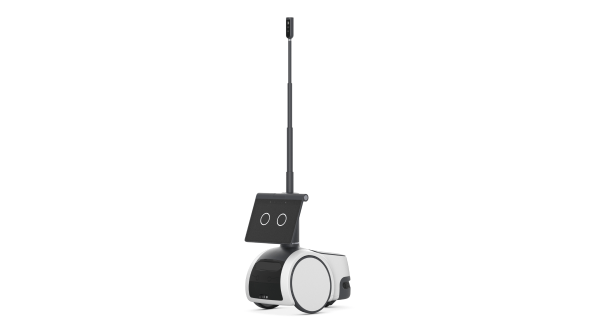
[Photo: courtesy of Amazon]
Astro can tool around your home at up to one meter per second, weighs about 20 pounds, and is designed to be easy to pick up. A camera mounted on a periscope-like extension can extend to a height of 42?, giving it the ability to get a better view of its surroundings.
Along with cameras, speakers, and microphones, Astro is packed with various sensors that help it navigate its world. They let it see the 3D space around it and construct a map for future navigation; detect objects in its way, such as objects, people, or pets; and avoid tumbling down stairs (which it’s unable to deal with—this is a one-floor bot). It comes with a charging dock and will return to it throughout the day, topping off its battery so that you don’t have to worry about it running out of juice.
So what does all this technology enable? A lot of it relates to home safety. Astro can serve as a mobile security camera, patrolling your house when you’re not there. If you subscribe to a new Amazon security service called Ring Protect Pro, the robot can save video clips of what it sees to Ring’s cloud storage. If it spots someone in the home when you’re not there, it can sound an alarm—which conjures up entertaining images of burglars being scared off by a robot no larger than a smallish dog.
Working with another service called Alexa Guard, Astro can detract sounds such as breaking glass or smoke detectors going off and alert you. You can also control the robot remotely—say, to scoot into the kitchen to verify that you remembered to turn off the stove.
Another area of focus for Astro is helping people keep tabs on loved ones, such as aging parents who may live far away. You could use the Astro smartphone app to instruct a robot at your parents’ home to find your father, or to look for him on a regular schedule—such as first thing in the morning—and report back. Astro works with a new service for caregivers called Alexa Together, and Amazon is also collaborating with Omron, a maker of health monitoring equipment, to use the robot to remind people to check their blood pressure.
A fair number of the tricks in Astro’s toolkit sound gimmicky rather than essential. It lets you listen to music, watch movies, and place video calls, and will follow you around as you do so. You can stick an item—such as a bottle of water—into its storage bin, then instruct it to deliver that cargo to someone in another room. And Tritschler says that his own Astro greets him at the door when he gets home from work. I was about to say that nobody would pay $1,000 for this stuff—but then again, that’s comparable to the price of a high-end smartphone, so some people surely will.
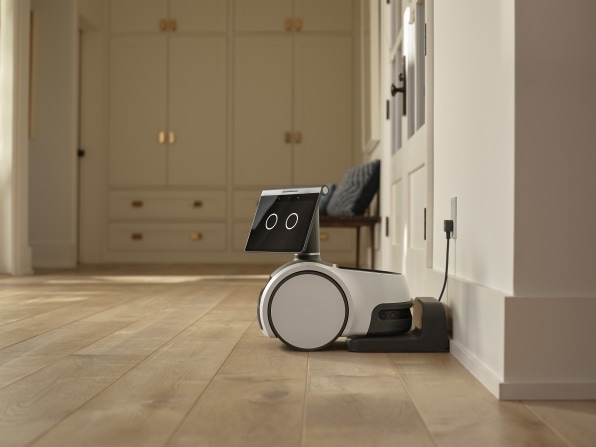
The matter of privacy
It’s easy to imagine gadget enthusiasts having fun with Astro. But it’s equally obvious that some people will bristle at the whole idea on privacy grounds. Putting always-on microphones and internet-connected cameras in a home introduces a range of potential pitfalls, many of which also apply to more conventional Amazon household devices such as its Echo smart speakers and screens. Stick those microphones and cameras on a robot that can autonomously cruise around a household, and the concerns only multiply. (Some of them are also issues with Amazon’s Ring flying home security drone, which the company is about to start selling as an invite-only product almost a year after announcing it.)
Tritschler says that Amazon gets that people will want assurance that Astro isn’t a privacy-invading machine: “We realized that was critical, so we always put the user in control.” For example, before you can manage Astro and watch its video feed from your phone, you must have the two devices in one place to pair them, reducing the chances of unauthorized access. When the robot is capturing video, the feed appears on its own screen, and a jumbo-sized green light on its periscope turns on, alerting those in its presence that they’re being recorded. A prominent button lets you shut off the robot’s cameras, microphones, sensors, and motor with one press, and you can bar it from venturing to specific areas of your home. (Tritschler gives bathrooms as an example, which illustrates the new hazards introduced by putting a camera on wheels.)
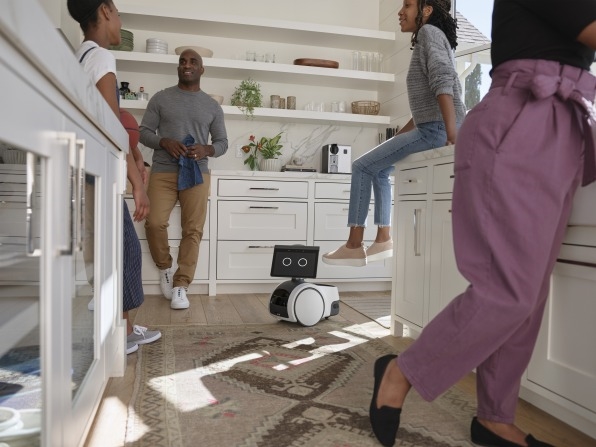
A feature called “Visual ID” lets you register family members’ faces so that Astro can find specific people in the household. The face prints it creates—from five different angles—are stored on the robot rather than in the cloud. And creating Visual IDs at all is optional.
Astro also constructs a map of your home to help it find its way around. That does get stored in Amazon’s cloud, a fact that has already sparked skepticism about what the company might do with this highly personal data. The company says that it won’t use such maps for marketing, advertising, or product recommendations.
Giving Amazon audio and visual access to goings-on in your home is always going to raise dystopian scenarios for some people, and Astro’s controls don’t address all of them. Still, if you’re worried about people secretly watching you, gadgets such as cheap, easily-hidden internet cams—some of them sold by Amazon itself—seem like a much bigger threat.
Ultimately, Astro is a first rough draft of the future of home robots at best. Amazon didn’t even try to give the robot the ability to deal with stairs or grab objects, but Tritschler says that it’s interested in both capabilities once the technology is ready. He also talks about Amazon robots being able to detect loneliness or depression, possibly as a means of aiding the well-being of older people. “We anticipate that will be something people will be interested in,” he says.
Should Amazon get into the mood-monitoring business, you can expect new controversies that go far beyond those provoked by Astro in its initial form. First, though, this robot has to prove that it’s not a Fire Phone-like blip among Amazon’s endless parade of big ideas— a possibility that Insider reported in March was already a fear among some on the Astro team.
Tritschler says that Astro isn’t a one-off experiment: “This is our first robot, but definitely not our last.” Which means that even those of us who aren’t about to drop $1,000 on a home robot—from Amazon or anyone else—might want to keep tabs on it from a distance.
(53)

